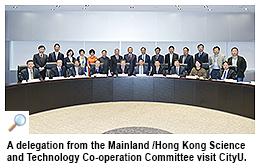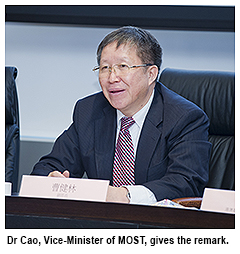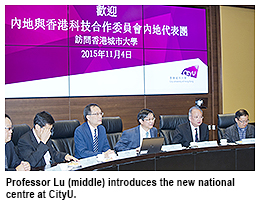New national centre at CityU boosts research on precious metals in engineering
Chan Pui-fun
The Ministry of Science and Technology (MOST) of the People’s Republic of China has recently approved the establishment of the Hong Kong Branch of National Precious Metals Material Engineering Research Centre (the Centre) at City University of Hong Kong (CityU).
The Hong Kong branch will promote research and the applications of precious metal elements and nanomaterial engineering technology, professional training and academic exchange.
With its expertise in the field, CityU is a leading institute in the research of advanced structural materials. Members of the Hong Kong branch have published more than 300 papers in world-class academic journals over the past five years. A five-year project, kicked off four years ago, conducted by Professor Lu Jian, Director of the Centre and Vice-President (Research and Technology) of CityU, and his research team received funding worth RMB9.34 million from both the National Basic Research Programme (known as “Programme 973”) and the matching fund provided by the Shenzhen Government.
Also, Professor Liu Chain-tsuan, University Distinguished Professor, received RMB1.5 million from MOST to support his research on advanced alloy.
The new established Centre will contribute to China’s economy by focusing on innovative research on precious metal materials and advanced processing technology. The aim is to meet the high demand for advanced metal materials in advanced technology industries and national defense. The Centre will receive annual funding cap worth HK$5 million from the Innovation and Technology Commission (ITC) of the Hong Kong SAR Government for the recruitment of researchers and the acquisition of advanced equipment.
A delegation from the Mainland /Hong Kong Science and Technology Co-operation Committee visited CityU on 4 November. Members of the delegation include representatives from MOST, the Hong Kong and Macao Affairs Office of the State Council, the Liaison Office of the Central People's Government in the HKSAR, the National Natural Science Foundation of China, the China Association for Science and Technology, Shenzhen Science, Technology and Innovation Commission, and ITC.
Dr Cao Jianlin, Vice-Minister of MOST, said, “We hope the Hong Kong branch will establish itself as a research centre of international standard and will strengthen ties with industrial leaders in mainland China for the advancement of technology in both mainland China and Hong Kong.”
Professor Lu presented the Centre to the delegation. Also, Professor Paul Lam Kwan-sing, Chief-of-Staff and Director of the State Key Laboratory in Marine Pollution, and Professor Chan Chi-hou, Director of the State Key Laboratory of Millimeter Waves (CityU’s partner laboratory), reported on the development of the two laboratories.
The research team at the Centre consists of 12 faculty members from CityU’s Department of Physics and Materials Science, Department of Mechanical and Biomedical Engineering, Department of Architecture and Civil Engineering and other related departments. The team includes a foreign member of the Chinese Academy of Engineering, member of the US National Academy of Engineering, an academician of the National Academy of Technologies of France, and experts in the areas of energy as well as material computation and simulation.
Elements of precious metals include gold, silver, platinum, palladium, rhodium, iridium, osmium and ruthenium. These elements have specific atomic structure and physical and chemical characteristics, for example, high temperature anti-oxidation, resistance to corrosion, excellent electricity conductivity and high catalytic activity.
As research on precious metals is closely related to the electronics, IT, catalysts, and jewellery industries, it plays an important role in Hong Kong’s economy.
“Gold, silver and platinum are well-known as materials for jewels and watches,” Professor Lu said. “But they also have wide industrial applications, just like other precious metals.” In fact, all mobile devices contain precious metals and all computer chips use gold. High-end computers even have a higher demand for extremely small interconnected gold metal.
CityU’s research team has successfully developed a nanotechnology to alter the structure of metals, increasing the hardness of 24k gold and pure gold by several times. Different to the electroplating currently used by most industrial practitioners, CityU’s nanotechnology is developed upon the principles of mechanics and physics. As no chemicals or other materials will be added during the process, the technology is 100% environmentally friendly.
Enhanced hardness can make the products made of metals more durable and scratch resistant. “The hardness of the 18k gold used in the Apple iWatch is 100% higher than that of ordinary 18k gold,” Professor Lu said.
Precious metals are also excellent catalysts and very efficient for the storage of energy. They can be used for alloy and aviation applications because their anti-oxidation characteristic is evident at high temperatures. The new Centre will develop new precious metal materials and improve existing ones with the aim to produce more reliable and durable products at a lower cost to meet the needs of social development.
“Our research areas include the development of a new generation of basic metal materials, precious metal nanomaterials and new material computation. For applications, we will focus on the integration, durability, lifespan and quality of precious metal materials,” Professor Lu said.
Professor Liu, together with scientists from four local universities, earlier received a grant of HK$10 million from the Research Grants Council. With the matching fund from CityU, a three-dimensional atom probe tomography (model: LEAP 5000) was purchased from CAMECA in the US. The Centre will make use of this state-of-the-art equipment for research in multi-element precious metal micro alloys.
The Hong Kong Branch of National Precious Metals Material Engineering Research Centre is the second batch of such branches of Chinese National Engineering Research Centres, nominated and sponsored by the Innovation and Technology Commission of the Hong Kong SAR Government.
CityU’s new centre will be jointly established by the University and National Research Centre for Precious Metal Materials and Engineering Technology at Kunming Institute of Precious Metals (KIPM). Known as the “cradle of platinum studies”, KIPM is the backbone of expertise and technology innovation for precious metals in China.


